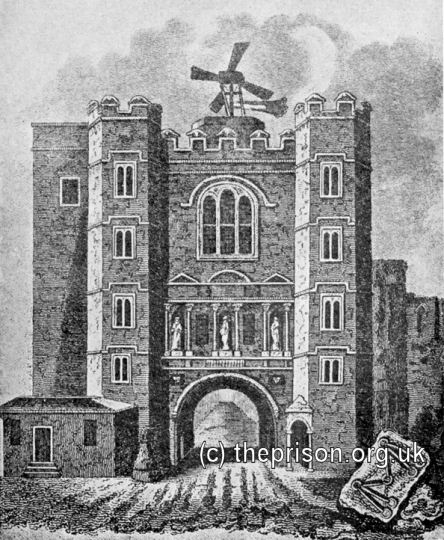Town Gaols
After County Gaols were established in the twelfth century, cities and larger towns began to follow suit. By the end of the Middle Ages (roughly 1500AD), there were prisons in every major town, plus others serving 'liberties' (areas in which rights reserved to the king had been devolved into private hands) and 'franchises' (areas where the right to operate a court of law was held by a variety of entities such as municipal corporations, religious houses, guilds, early universities, the Welsh Marches, and counties palatine).
The gaols serving towns were often located in town gates, which provided a secure building in which to hold prisoners. One of the best known examples of such gaol is Newgate, dating from 1188 and located in one of City of London's old gatehouses. Bridges, too, sometimes suitable accommodation, as happened at York in bridge over the River Ouse.

Newgate Gaol, London, c.1750. © Peter Higginbotham
Town gaols often shared a site which was also used other functions, such as a town hall, guildhall, courthouse or bridewell.
Bibliography
- Higginbotham, Peter The Prison Cookbook: A History of the English Prison and its Food (2010, The History Press)
- Brodie, A. Behind Bars - The Hidden Architecture of England's Prisons (2000, English Heritage)
- Brodie, A., Croom, J. & Davies, J.O. English Prisons: An Architectural History (2002, English Heritage)
- Harding, C., Hines, B., Ireland, R., Rawlings, P. Imprisonment in England and Wales (1985, Croom Helm)
- McConville, Sean A History of English Prison Administration: Volume I 1750-1877 (1981, Routledge & Kegan Paul)
- Morris, N. and Rothman, D.G. (eds.) The Oxfod History of the Prison (1997, OUP)
- Pugh R.B. Imprisonment in Medieval England (1968, CUP)
Links
- Prison Oracle - resources those involved in present-day UK prisons.
- GOV.UK - UK Government's information on sentencing, probation and support for families.
Except where indicated, this page () © Peter Higginbotham. Contents may not be reproduced without permission.



